|
Listen to this post
|
Thursday, September 15, 2022. The Ides of September. Awoke as usual at 6 a.m. and took another photo from the bow of the Wilderness Discoverer. Today, we travel to Sitka. This was the original state capital and the location where Russia handed over Alaska to the U.S. in 1867.
Breakfast today was eggs benedict, bacon, scrambled eggs, zucchini bread, and a cinnamon twist. Have I mentioned that the food on this trip is amazing?
We get to tour parts of Sitka today in the afternoon and need to be on board before 5:30 when we leave. I noted the gangway to shore was on the sun deck (top level) when we left to visit Sitka; it was located one deck lower upon our return from the city. Tides, enough said. Lunch was served at 12:30 after our morning tours and we had the afternoon for an urban meander (on our own).
We left the ship at 8:45 for a tour of the Alaska Raptor Center and the Fortress of the Bear. In route, we learned that 80% of the forest in Alaska is edible. Mostly roots, bark, and berries. You just have to know which 80% There are three kinds of huckleberry here. The red one is most closely related to blueberries. If the bush has a square stem, it is likely a huckleberry (assuming there are berries visible now). There are 8 species of blueberries known from Alaska. I did not realize these nuggets of knowledge.
We stayed at the Alaska Raptor Center for about an hour. We learned that a mature bald eagle has roughly 7,000 feathers. They treat roughly 200 injured birds each year. From hummingbirds to eagles. An eagle weighs roughly 12 points. The males are smaller and feed on smaller prey. Staff members have to trim the talons and beak every 6 months while the eagle is recovering. We also learned that acute lead poisoning is easier to treat than prolonged exposure to lead. The former might be caused by an eagle eating a carcass which was killed with lead shot.
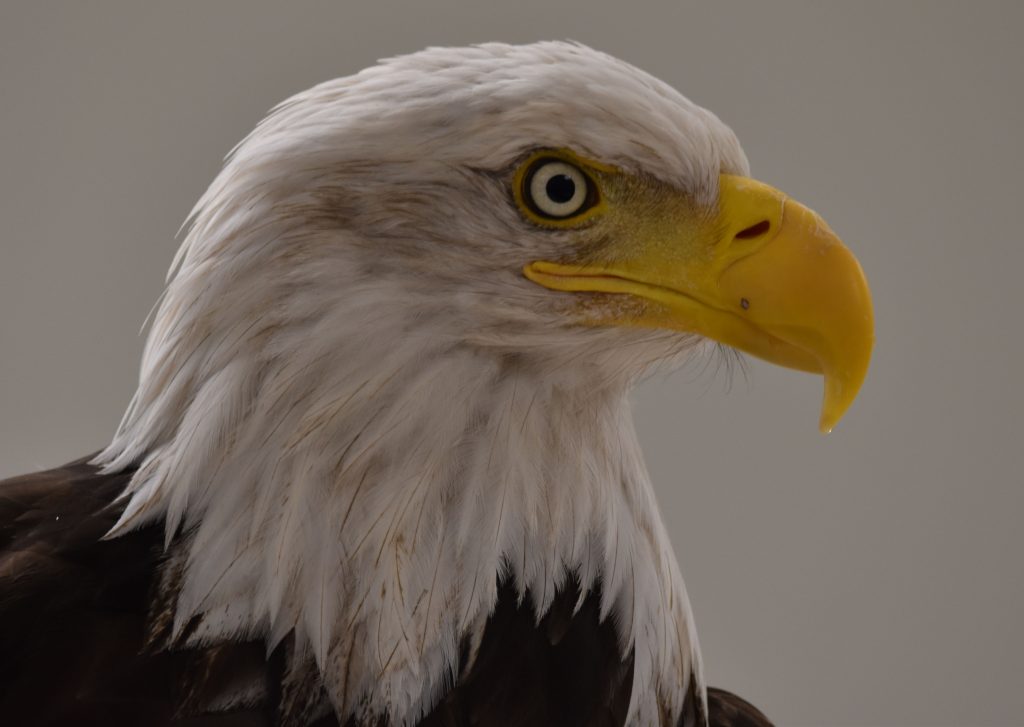
We wandered some of the trails while at the Alaska Raptor Center. This was one of the views of a stream as we walked along the trail.
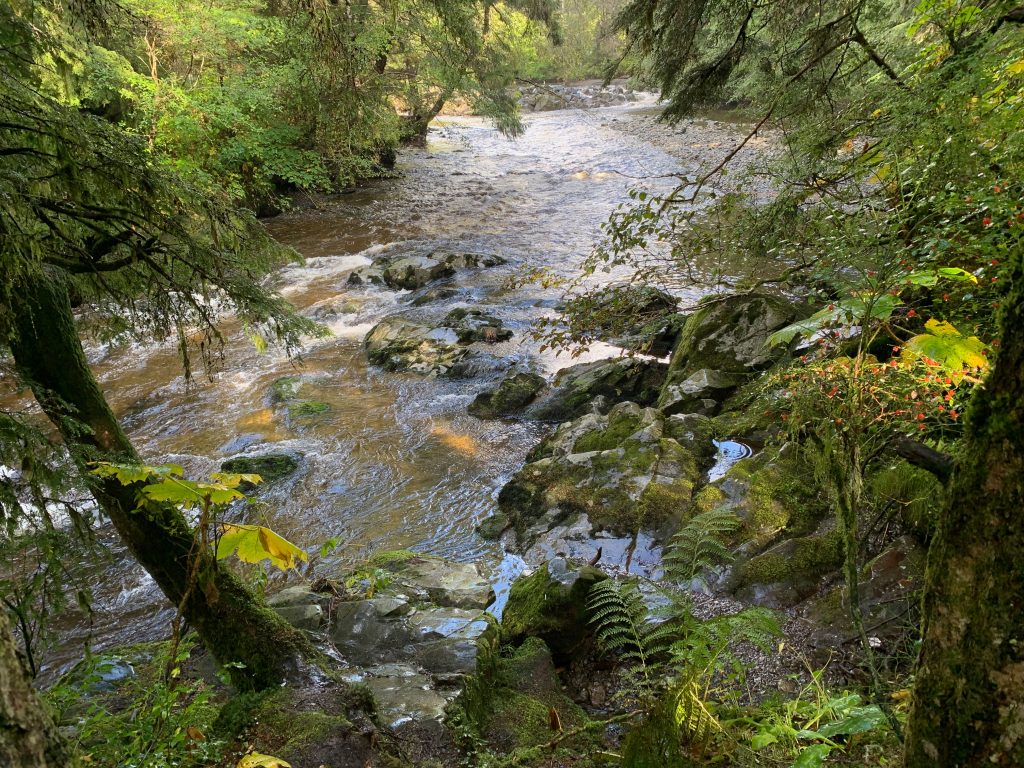
We took a short bus ride to the Fortress of the Bear. This is another rescue center. Essentially, bears which continue to visit humans are either euthanized or sent to “bear prison.” OK, not really a prison, but the bears can not be released back in to the wild. They live out their lives in this rescue center. Also, cubs which have lost their mother and can not fend for themselves or injured bears which can not survive in the wild are also cared for at this center. Both black bears (Ursus americanus) and brown bears (Ursus arctos) are kept here. Black bears are the smallest of the North American bears. It is estimated that roughly 100,000 black bears inhabit Alaska. Brown bears are typically larger than black bears. They have a more prominent shoulder hump and less prominent ears than black bears. Color is not a good separator.
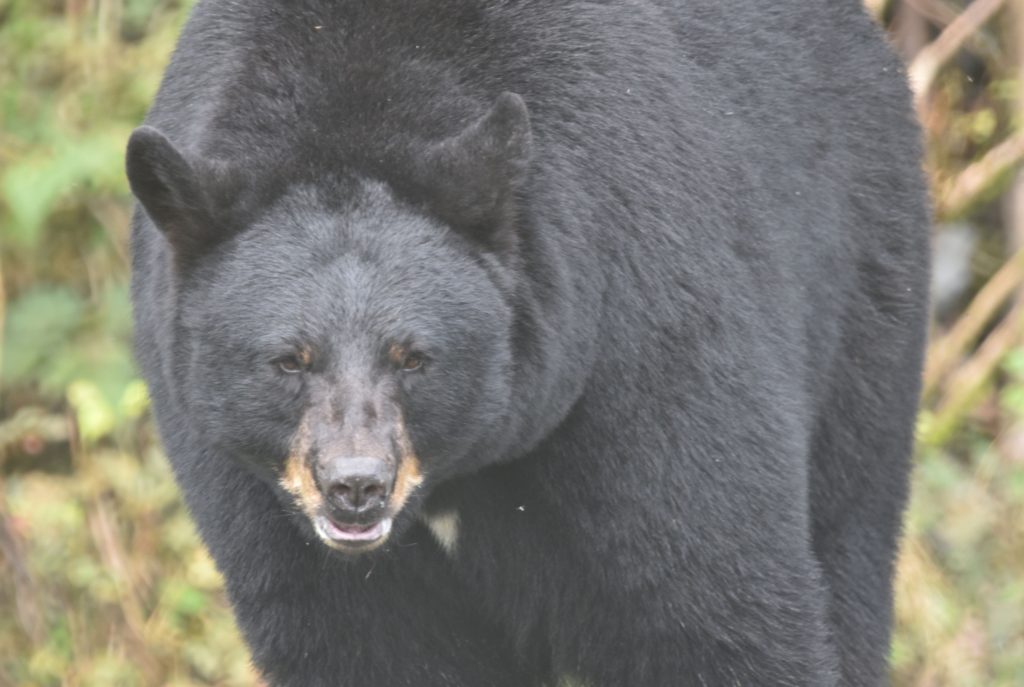
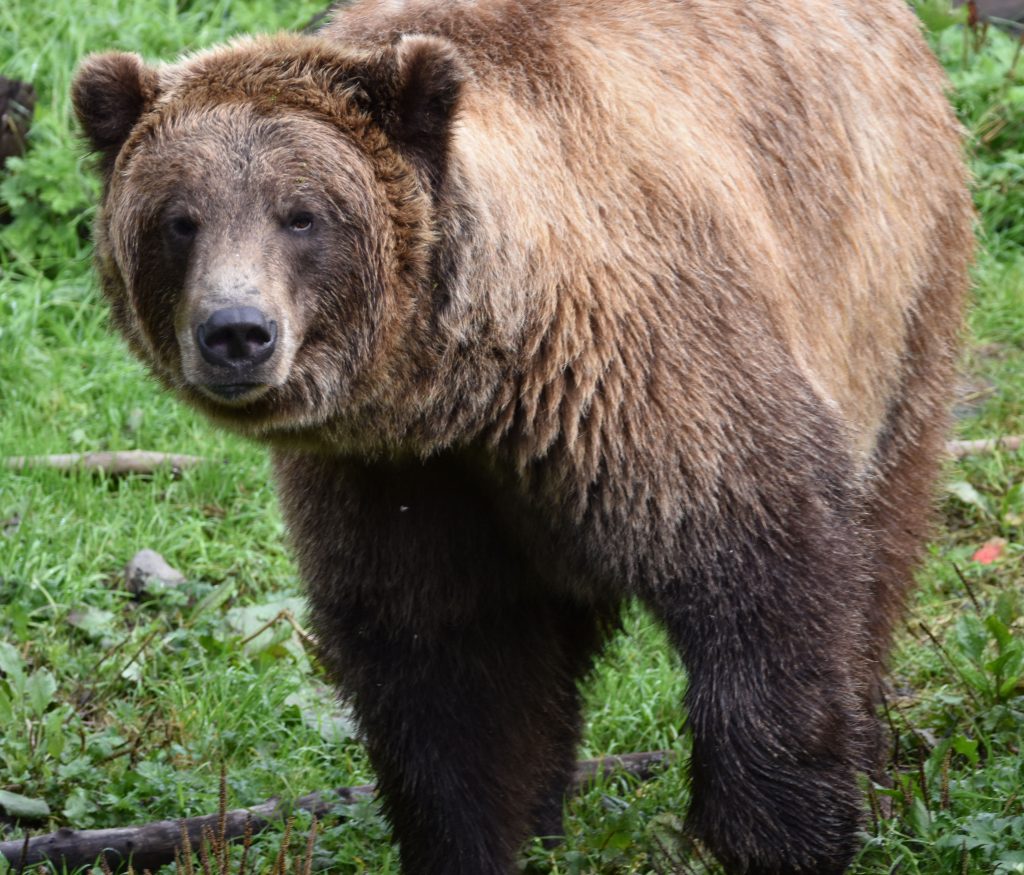
I can not stress enough that one should only use significant telephoto lens when approaching such a magnificent animal. They can run much faster than any human. I used a 600 mm lens for these photos.
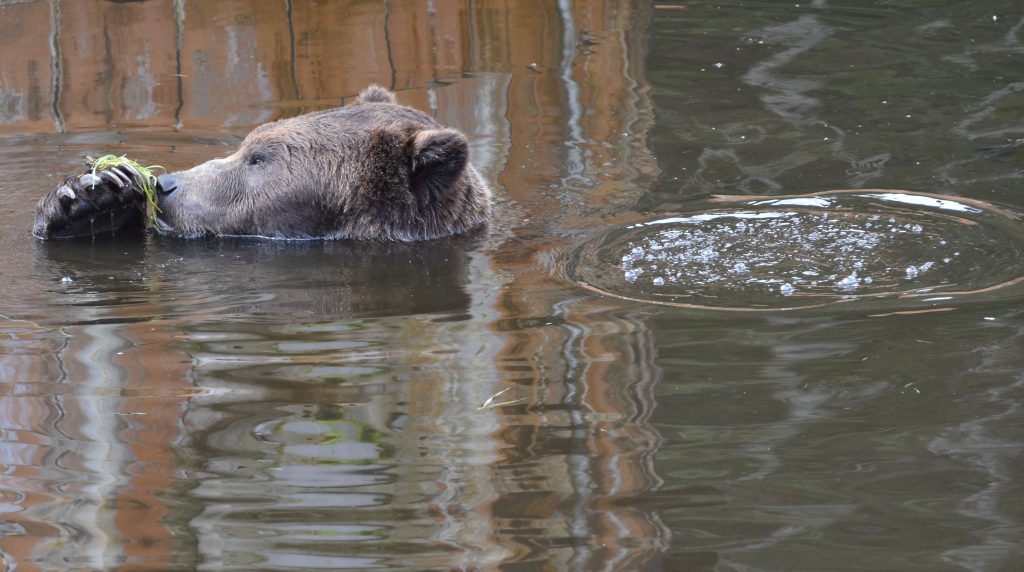
I know, the teenager in me chuckles every time I see this photo. The bear seems a bit relieved. No Photoshop was involved (other than cropping the image).
On way back to our ship, we learned that the number one industry in Sitka is healthcare. Number 2 is government (combining state and national government employees); tourism is number 3 in a typical year. The past few years have been anything but typical for tourism and the area is suffering mightily. There are a total of 14 miles of paved highway in the Sitka area. Yes, 14. And, many of those miles are under construction/ repair most of the time. There are 9,000 year round residents. There are 3 high schools. One high school is for students from outlying areas (it is residential). Over 10,000 apply and only 400 are admitted each year. If you get a “D” in any subject your are expelled. If any “C” you have to work an hour extra each day and spend Saturday studying as well. Keep in mind, this is a high school.
For lunch, we returned to the ship and had lunch about 12:30. Pulled pork, mac and cheese, cole slaw, steak fries and berry cobbler for dessert. Another fantastic meal.
After lunch we toured the city of Sitka. We went to Castle Hill and I took a 360 photo. This is where Alaska was handed over from the Russians to the United States in 1867.
Visited Sitka, Alaska on September 15, 2022. At this spot (Baranof Castle), Russia transferred Alaska to the U.S. in 1867. After the transfer was completed, the Russians walked to their ships and did not return. #SEAK22WD #theta360 – Spherical Image – RICOH THETA
Due to the Crimean War, Russia was in need of money and offered to sell Alaska in 1857. We had to fight our Civil War before we could finalize the transaction. Russia did not want Great Britain to have Alaska as they were controlling Canada. And, Russia had just fought the British in Crimea (“half a league, half a league” … was penned about this war). However, Russia could not easily defend the territory and they knew it. They were in Alaska only to extract resources (such as furs). As soon as transaction was completed, the Russians walked down the hill and boarded their ship never to return.
Of course, I had to also take a number of photos of this iconic church.
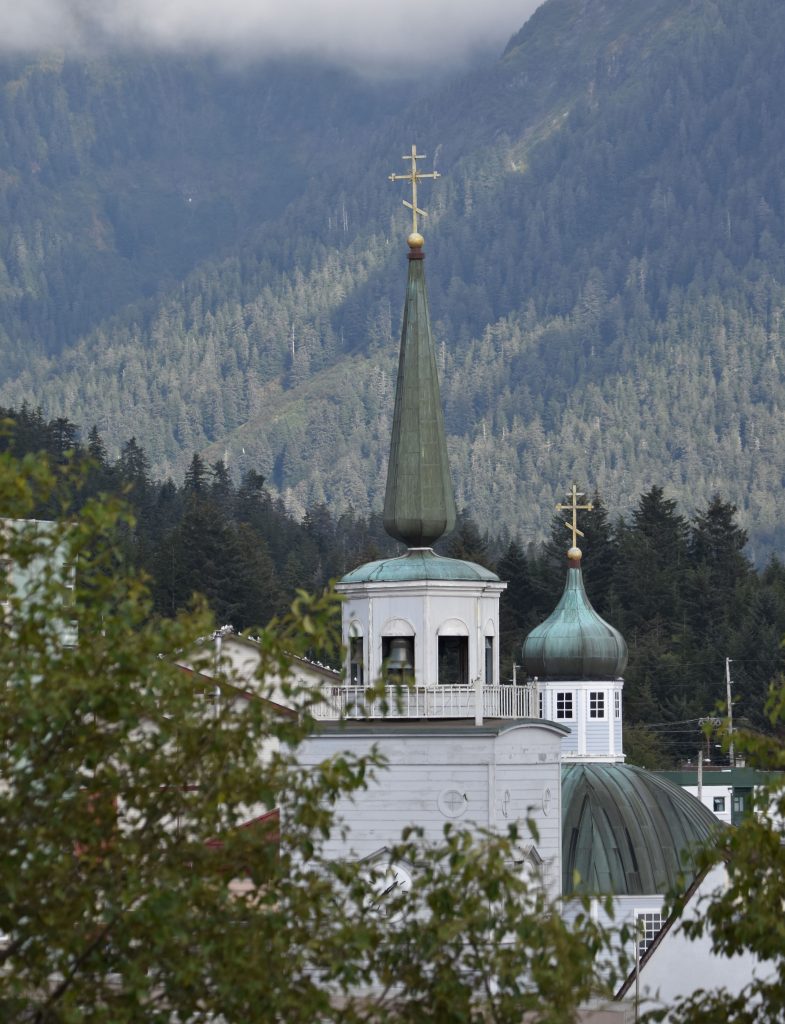
We also visited Totem Park. Although we saw a number of totem poles throughout the trip, there was only one in this park.
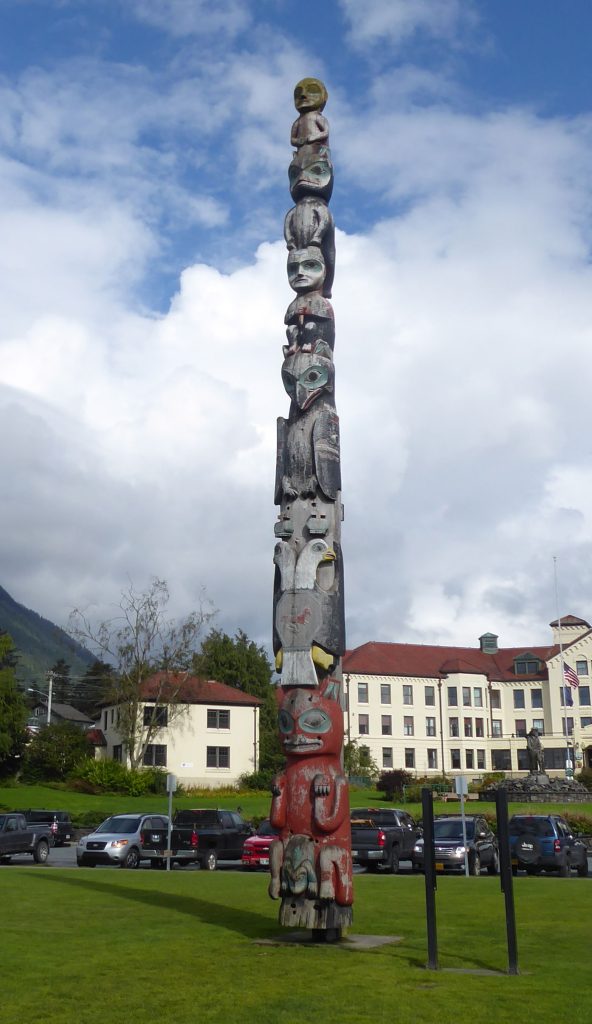
Ruth spotted a “wooly bear” caterpillar along the curb near Totem Park. Lophocampa maculata is the likely species. Spotted tussock moth is the common name (family Erebidae). This caterpillar is about 1.5 inches long (and heading away from us).
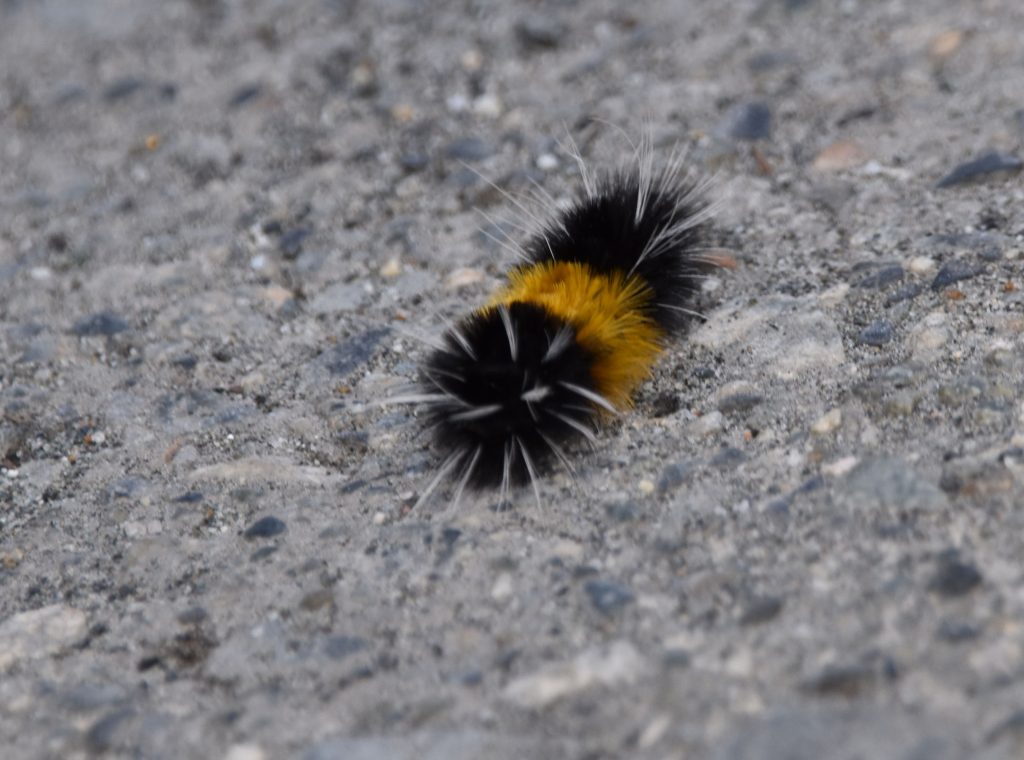
While in Sitka, we visited several shops and examined their wares. Found Ruth a nice fur coat for $30,000. And it was at a 40% discount. We moved on. We returned to the ship about 3:30 p.m.
Doug (one of our guides) gave a presentation about bears after dinner. It was “Beary important” information. That was the title of his talk.
There are 8 species of bears in the world today. The closest living relative is the harbor seal. This is based on bone structure and skull.
About 20 million years ago the giant panda split off from the remainder. The panda does not eat meat nor does it mate enthusiastically. It is significantly different from the other living bears in these respects (and more).
Species of bear today include the black bear, polar bear, brown bear (including the coastal brown bear and the grizzly – both are subspecies), the spectacled bear, the sloth bear, the Asiatic black bear, the panda, and the sun bear. In southeast Alaska, the coastal brown bear and the black bear are encountered. Colors vary extensively. The brown bear has a hump on its back and short ears. The black bear lacks the hump and has longer ears. Both were seen at the Fortress of the Bear (see photos above). Paw prints – brown bears have a more rectangular pad and black bears have a more rounded pad.
Life during annual seasons: summer is mating season. If multiple cubs, each may have a different father. Fall is spent eating salmon and berries. They often eat just the roe and brains of salmon. The rest decompose or feed other animals. Saying – salmon is in the trees here. The salmon carcasses help fertilize and enrich the forest. In winter, they den – they do not hibernate but do experience torpor. Females give birth. Typically den above the tree line. In spring, they emerge and eat sedges and other plants. Their sense of vision is about the same as ours. Their sense of smell is about 5,000 times better than a dog. They have scent glands in their paws and smell each other’s tracks. As human populations increase so do bear encounters. Brown bears are more likely to attack. Black bears are curious but afraid of everything. Surprising a bear is the main reason for conflict. Always a good idea to make a lot of noise in bear country. A bear can run at 35 mph and can weigh 900 pounds.
After the presentation, we talked with others for a while. It is great to be able to meet so many interesting people. Another day awaits. More about September 16, 2022 coming soon.


